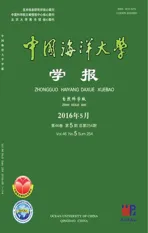威海小石岛人工鱼礁区渔获物组成特征及与环境因子的关系❋
2016-06-16唐衍力孙晓梅盛化香王新萌
唐衍力, 孙晓梅, 盛化香, 王新萌, 万 荣
(中国海洋大学水产学院,山东 青岛 266003)
威海小石岛人工鱼礁区渔获物组成特征及与环境因子的关系❋
唐衍力, 孙晓梅, 盛化香, 王新萌, 万荣
(中国海洋大学水产学院,山东 青岛 266003)
摘要:于2012年9月—2013年7月采集了威海小石岛人工鱼礁区和对照区4个季度的刺网渔获物和环境数据。基于该调查数据,应用物种多样性指数和多元分析法,研究了鱼礁区与对照区渔获物的种类组成、多样性、群落结构以及渔获物与环境因子的关系。研究表明:鱼礁区的渔获物共23种,其中鱼类17种、甲壳类5种、棘皮类1种;对照区的渔获物共14种,其中鱼类8种、甲壳类5种、棘皮类1种。鱼礁区与对照区渔获物的种类丰富度指数、多样性指数和均匀度指数无显著性差异(P>0.05)。聚类分析和非度量多维尺度分析(NMDS)显示,鱼礁区与对照区的渔获物可分为秋季组、夏季组和冬春季组;不同季节的渔获物群落组成差异显著(R=0.867 4,P=0.001),鱼礁区与对照区的渔获物群落组成差异不显著(R=0.137,P=0.067)。典范对应分析表明,水温、pH、盐度、叶绿素a和PO4-P是影响威海小石岛人工鱼礁区群落结构的主要环境因子。综合分析认为,人工鱼礁区渔获量较高,生态稳定性较好。
关键词:人工鱼礁区;渔获物;种类组成;物种多样性;聚类分析;环境因子;典范对应分析(CCA)
引用格式:唐衍力,孙晓梅,盛化香,等. 威海小石岛人工鱼礁区渔获物组成特征及与环境因子的关系[J].中国海洋大学学报(自然科学版), 2016, 46(5): 22-31.
TANG Yan-Li, SUN Xiao-Mei, SHENG Hua-Xiang, et al. Community structure of catch and Its relationship with environmental factors in Xiaoshidao artificial reef zones of Weihai City [J].Periodical of Ocean University of China, 2016, 46(5): 22-31.
由于中国近海渔业资源严重衰退,渔获物种类结构发生显著变化[1-2]。为改善水生生物栖息环境,修复受损的海洋生态系统,各沿海地区积极开展人工鱼礁建设[3-4]。人工鱼礁能够为不同的鱼类提供索饵、避害、产卵、定位的场所,限制底拖网作业[5],同时改善水域生态环境[6-7]。威海小石岛位于山东半岛东端的黄海海域,周边海域自2005年开始进行了大规模的增殖型人工鱼礁建设,投放的礁体主要是石块和混凝土构件,取得了明显增殖的效果[4]。
人工鱼礁区资源量的生态调查是评价人工鱼礁生态修复效果的重要途径之一[8],而选择适合的采样工具是准确评估渔业资源群落的关键。由于鱼礁区水域水深较浅、底形复杂,目前国内在岩礁生境较多使用定置三重刺网[9-10],其操作灵活、与海底接触面积小,能有效捕获鱼礁区资源。目前关于人工鱼礁区渔业资源群落组成[11-13]和流场效应的研究[14-17]较多,而国内在人工鱼礁区鱼类生物群落结构的时空分布及受多种环境因子的影响与制约方面的研究较少。
本文根据2012年9月—2013年7月对威海小石岛人工鱼礁区和对照区刺网渔获物及环境因子的调查数据,分析不同季节和不同区域的渔获组成、多样性和群落结构特征的变化,同时用R语言Vegan包提供的典范对应分析(CCA)确定对渔获物群落组成具有显著影响的环境因子,探讨该海域人工鱼礁投放对渔获资源的影响,为科学合理地评价人工鱼礁建设的生态效果及合理利用渔业资源提供参考。
1材料与方法
1.1 取样地点
威海小石岛人工鱼礁区水深5~15m,海域面积48hm2。2005—2007年间共投大石块约5万m3,混凝土构件礁2.5万空m3,报废渔船50艘,0.36万空m3。
本研究在人工鱼礁区(见表1和图1中虚线区域)设置3个调查站位,章守宇等[18]认为实际海域由于鱼礁设置所产生的流场影响范围在水平尺度上一般不超过鱼礁单体大小的50倍,本研究将对照区设置在距鱼礁区最小距离为780m的区域,共3个站位(见图1和表1)。每次采样严格在原坐标下设置网具。
1.2 样品采集与分析
2012年9月(秋季)、2012年12月(冬季)、2013年4月(春季)、2013年7月(夏季)进行了4个季度的刺网取样,每个站位渔获物带回实验室,对其进行种类鉴定,并分类计数、称重。水温(Tem)、盐度(Sal)、pH、透明度(Tra)、化学需氧量(COD)、生化需氧量(BOD5)、硅酸盐(SiO3-Si)、磷酸盐(PO4-P)、可溶性无机氮(DIN)、溶解氧(DO)和叶绿素a浓度(chl-a)11个环境因子的采集和分析均按《海洋监测规范》(GB 17378.1-2007)[19]和《海洋调查规范》(GB/T 12763.4-2007)[20]的规定进行。
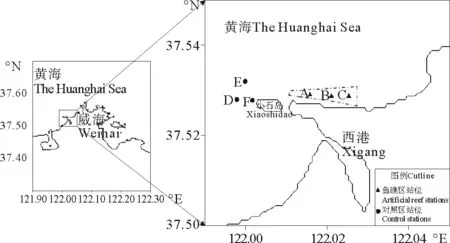
图1 鱼礁区与对照区刺网调查站位

区域Region鱼礁区ArtificialreefzonesABC对照区ControlzonesDEF经度Longitude122°00'57.10″E122°01'16.20″E122°01'31.35″E121°59'52.80″E122°0'0.00″E122°00'6.45″E纬度Latitude37°31'45.00″N37°31'43.90″N37°31'43.90″N37°31'40.80″N37°31'55.20″N37°31'40.11″N
采样所用网具为三重刺网,外网网目尺寸为10cm,缩结系数为0.56,内网网目尺寸为4.2cm,缩结系数为0.44,网全长28m,高3m。每个站位放置1张刺网,选择底层放置,距离海底0.5m。网具在海域内迎流放置24h。
1.3 数据处理
对原始数据进行标准化,将各站位每网渔获质量和尾数标准化成作业时间24h渔获值。
采用Pinkas相对重要性指数IRI(Index of Relative Importance)来研究群落优势种的组成[21]。
IRI=(N+W)×F×104。
式中:N为某个种类的尾数占总渔获的数量分数;W为某个种类的重量占总渔获的重量分数;F为某个种类在样品中出现的频率[22]。规定IRI大于1000为优势种,在100~1000之间为主要种,在10~100之间为常见种,在1~10之间为一般种,在1以下为少见种。
由于渔获物不同种类及同种类个体间数量、重量差异很大,根据威海小石岛人工鱼礁区和对照区渔获物群落的特点及取样数据,群落多样性[23]采用以下公式计算:
物种丰富度指数(Magelef′ index):
D=(S-1)/log2N。
物种多样性指数(Shannon—Wiener index):
H′=-∑Pilog2Pi。
物种均匀度指数(Pielou′ index):
I=H′/log2S。
式中:S为种类数;N为总渔获尾数;Pi为i种鱼占总渔获的数量分数。
在进行群落结构分析之前,对原始数据进行预处理。为了减少机会种的影响,删除占总个体数1%以下的物种[24],对渔获质量数据和环境数据采用lg(x+1)对数转换,以降低少数优势种对数据分析的影响使其更接近正态分布[25-26]。
利用Bray-Cutis相似性系数构建相似性矩阵[27],进行聚类分析和非度量多维尺度分析(NMDS),然后将威海小石岛人工鱼礁区渔获物群落分成若干站位组,应用单因子相似性分析(ANOSIM)研究不同季节及鱼礁区与对照区间的群落结构差异显著性。
分析4个季度渔获物和环境因子关系,先将预处理后的渔获量数据进行去趋势对应分析(DCA),并根据DCA分析结果中前4个轴长度选择排序模型,如果最长排序轴长度>4,选择基于单峰模型的典范对应分析(CCA),<3线性模型比较合适,介3~4之间2种模型均合适[28-30]。在CCA分析过程中,运用蒙特卡罗检验分析评价单一环境因子对渔获物群落变化影响的显著程度[31-32]。
群落结构聚类分析、非度量多维尺度分析(NMDS)和典范对应分析(CCA)均采用R2.11.1软件的vegan包实现。
2结果
2.1 渔获物组成
鱼礁区渔获物共出现种类23种(见表2)。其中,鱼类17种,隶属于6目14科17属,均属于硬骨鱼类,鲈形目种类最多,有7种,占总种类数的30.43%;甲壳类5种,隶属于2目5科5属;棘皮类1种,隶属于1目1科1属。
对照区渔获物共出现种类14种(见表2)。其中,鱼类8种,隶属于3目8科8属,均属于硬骨鱼类,鲈形目种类最多,有4种,占总种类数的28.57%;甲壳类5种,隶属于2目5科5属;棘皮类1种,隶属于1目1科1属。
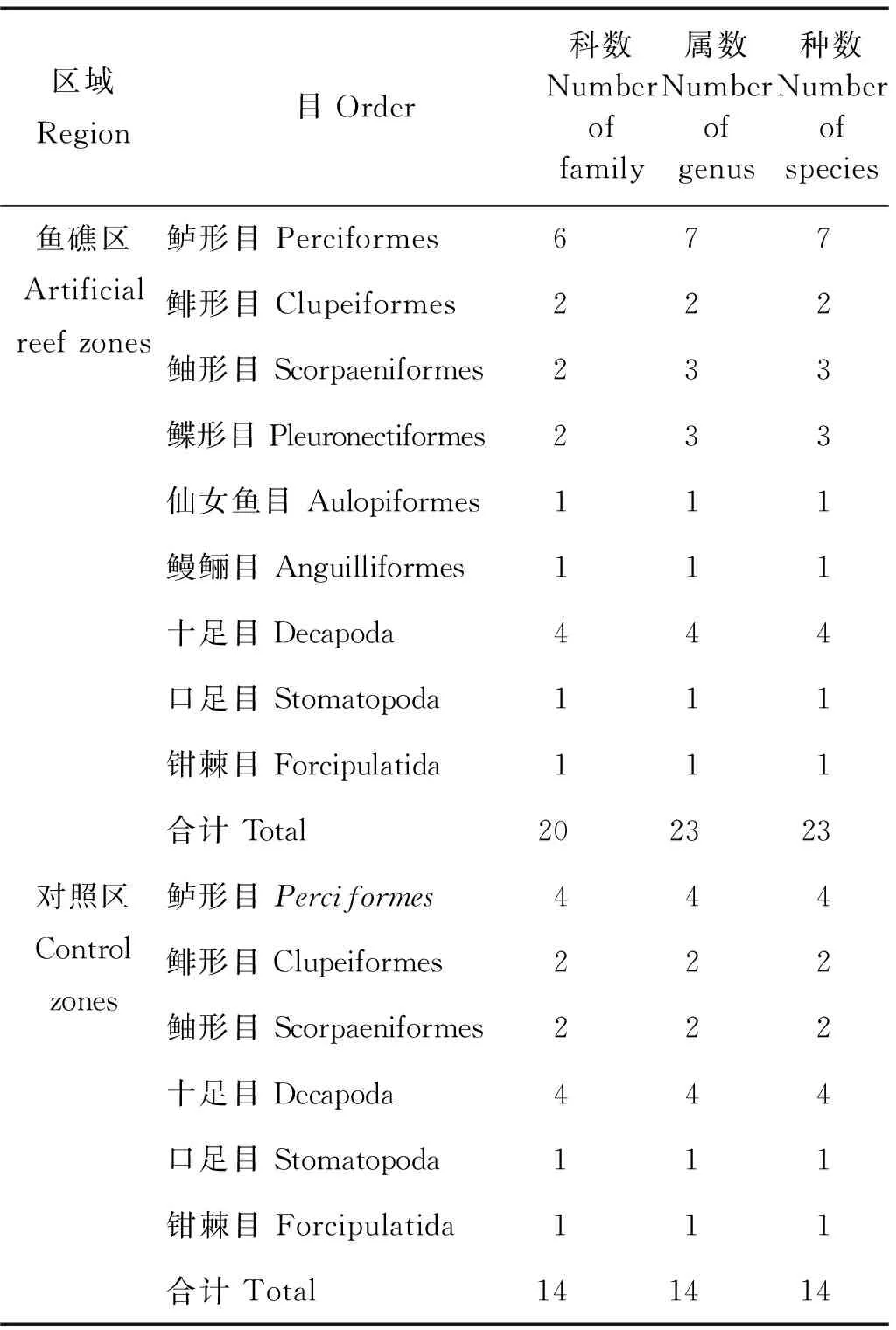
表2 鱼礁区与对照区渔获物组成
不同季节渔获物种类组成差异很大。鱼礁区与对照区各季节渔获物所占质量百分比、数量百分比和相对重要性指数见表3。
根据各渔获物种类相对重要性指数大小,鱼礁区秋季优势种为星康吉鳗、斑鰶、蓝点马鲛、赤鼻棱鳀,冬季优势种为多棘海盘车、大泷六线鱼、圆斑星鲽,春季优势种为口虾蛄、多棘海盘车,夏季优势种为赤鼻棱鳀、许氏平鮋、日本蟳、大泷六线鱼。对照区秋季优势种为赤鼻棱鳀、斑鰶,冬季优势种为大泷六线鱼、多棘海盘车、枯瘦突眼蟹,春季优势种为口虾蛄、多棘海盘车、许氏平鮋,夏季优势种为许氏平鮋、鲐鱼、大泷六线鱼。
2.2 渔获物物种多样性
鱼礁区与对照区各季节渔获物的群落种类丰富度指数D、Shannon多样性指数H′和种类均匀度指数J如表4所示。鱼礁区种类丰富度指数D的变化范围为0.98~2.89,冬季最低,秋季最高;多样性指数H'的变化范围为1.58~3.20,夏季最低,秋季最高;种类均匀度指数J的变化范围为0.61~0.92,夏季最低,秋季最高。总体上,春、秋季的多样性指数较高,夏、冬季的多样性指数较低。方差分析显示,鱼礁区与对照区的种类丰富度指数、多样性指数和均匀度指数均不存在显著性差异(P>0.05)。
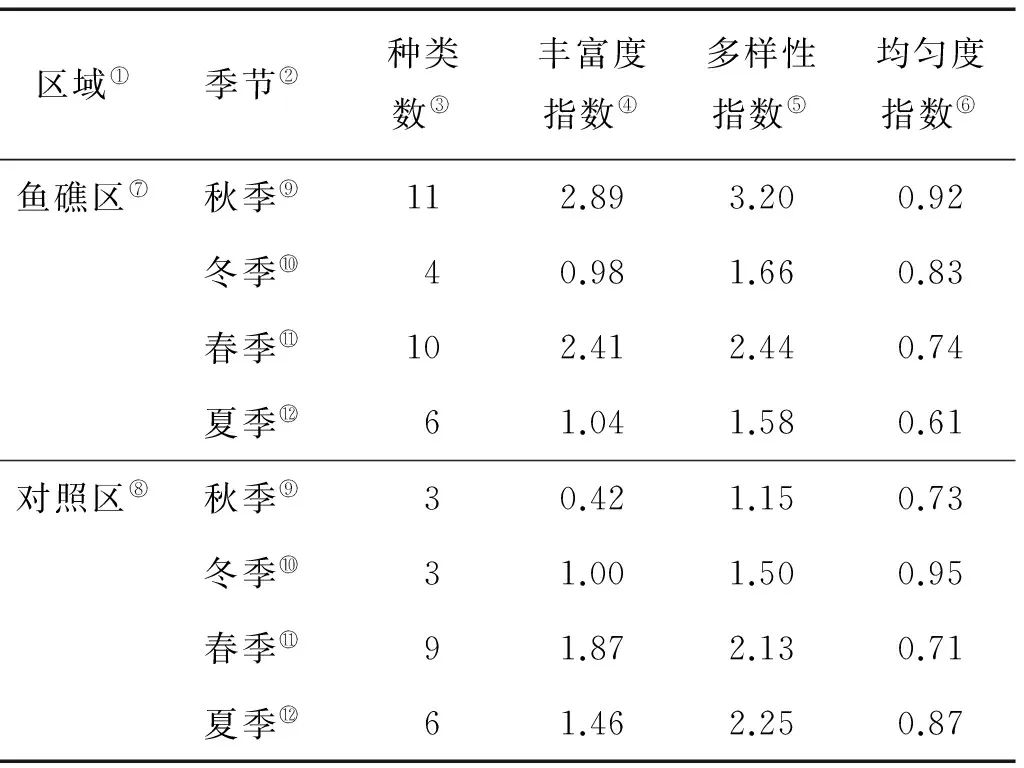
表4 鱼礁区与对照区渔获物群落多样性指数

2.3 渔获物类别组成
图2为4个季节鱼礁区刺网渔获类别组成。渔获物的尾数比,秋季和夏季鱼类在渔获物中比例明显占主要地位(>80%),高于其他种类在渔获物中的比例,冬季和春季鱼类在渔获物中比例有所下降;鱼类在渔获物中比例秋季和夏季相差不大,分别为84.85%和82.43%,明显高于冬季和春季,虾蟹类在渔获物中比例春季最高,为50.01%,冬季最低,为4%,棘皮类在渔获物中比例冬季最高,为44.02%。渔获物重量比,4个季节鱼类在渔获物中比例明显占主要地位(>80%),高于其他种类在渔获物中的比例;鱼类在渔获唐衍力表3
物中比例秋季、冬季和夏季下差不大,分别为92.25%,95.65%和82.43%,春季最低,为65.09%,虾蟹类在渔获物中比例春季和夏季较高,分别为25.93%和17.57%,冬季最低,为0.26%,棘皮类在渔获物中比例春季较高,为8.98%。
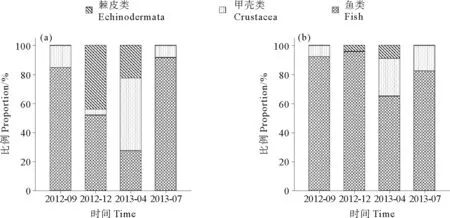
图2 鱼礁区渔获物(a)尾数(b)重量群落结构季节变化
群落划分采用聚类分析和非度量多维尺度分析(NMDS),2种方法的结果基本一致(见图3(a),3(b))。鱼礁区与对照区渔获物可分为3个站位组:组Ⅰ(秋季组)包括鱼礁区2012年9月A站位、2012年9月B站位、2012年9月C站位和对照区2012年9月D站位;组Ⅱ(夏季组)包括鱼礁区2013年7月A站位、2013年7月C站位和对照区2013年7月D站位、2013年7月E站位;组Ⅲ(冬春季组)包括鱼礁区与对照区2012年12月、2013年4月所有站位和对照区2013年7月F站位。聚类分析表明,鱼礁区与对照区渔获物具有明显的季节变化。One-Way ANOSIM表明,不同季节渔获物群落组成存在显著差异(R=0.8674,P=0.001),各季节鱼礁区与对照区渔获物群落组成无显著差异(R=0.137,P=0.067),但P值已接近显著水平0.05。
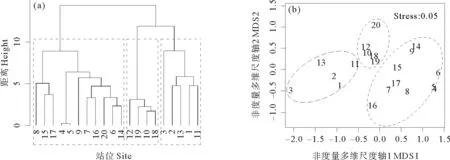
(1:2012-09A, 2:2012-09B, 3:2012-09C, 4:2012-12A, 5:2012-12B, 6:2012-12C, 7:2013-04A, 8:2013-04B, 9:2013-04C,10:2013-07A,11:2013-07B,12:2013-07C,13:2012-09D,14:2012-12D,15:2013-04D,16:2013-04E,17:2013-04F,18:2013-07D,19:2013-07E,20:2013-07F。 红色虚线框:变量分类。The red dotted line box: Classification of variables.)
图3鱼礁区与对照区渔获结构聚类分析(a)和NMDS 分析(b)
Fig.3Cluster analysis dendrogram(a) and NMDS results(b) for catches composition based on
weight between artificial reef and control zones
2.4 渔获物群落与环境因子关系
用于排序的渔获物及其排序中的种类代码见表5。DCA排序表明,前4个排序轴长度分别为7.2765、4.4809、1.714和1.0637,4个轴中长度最长大于4,选择单峰模型比较合理。
在DCA分析的基础上,对鱼礁区与对照区渔获物群落进行CCA分析,11个环境因子能解释78.29%的渔获物群落变化,蒙特卡罗置换检验(P=0.001)说明排序的结果可以接受11个环境因子对物种分布的解释量。鱼礁区与对照区各站位渔获物与环境因子的CCA二维排序见图4。叶绿素a、水温、盐度、pH、DIN和PO4-P与影响群落变化的第一主成分轴相关性高,对渔获物群落变化影响较大;DO与第二主成分轴相关性较高。相同季节不同站位的样方在图上位置接近,其结构组成相似。夏秋季各站位渔获结构与水温、叶绿素a、pH和盐度呈正相关,与PO4-P和DO呈负相关;冬春季则相反。
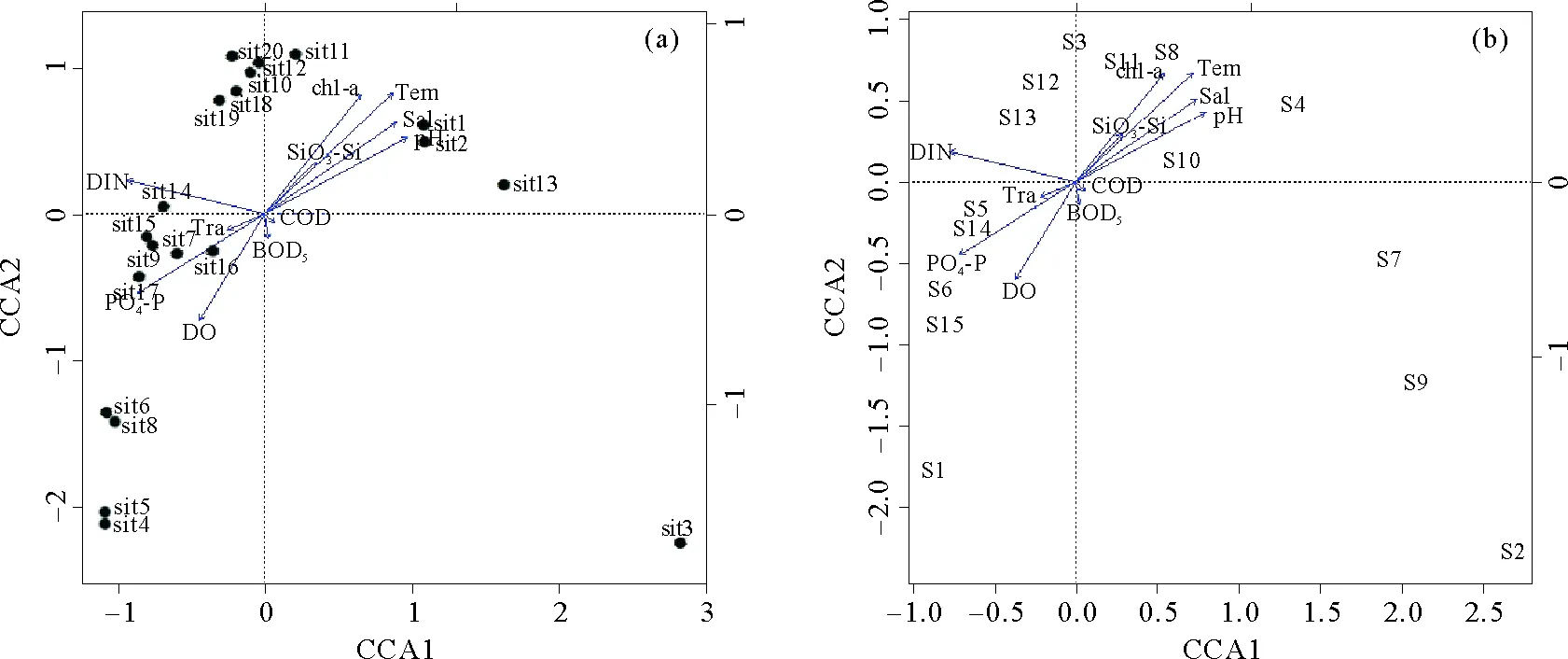
(sit1:2012-09A, sit2:2012-09B, sit3:2012-09C, sit4:2012-12A, sit5:2012-12B, sit6:2012-12C, sit7:2013-04A, sit8:2013-04B, sit9:2013-04C, sit10:2013-07A, sit11:2013-07B, sit12:2013-07C, sit13:2012-09D, sit14:2012-12D, sit15:2013-04D, sit16:2013-04E, sit17:2013-04F, sit18:2013-07D, sit19:2013-07E, sit20:2013-07F. s1~s20: 渔获物种类1~20 Catch species 1~20.)

图4 鱼礁区与对照区各站位(a)和渔获物(b)与环境因子的CCA排序图
各环境因子与排序轴的相关性见表6。比较环境因子对物种分布的决定系数r2,水温是渔获物群落分布的主要解释因子,透明度、COD、BOD5和SiO3-Si对渔获物群落分布影响不显著。蓝点马鲛、小黄鱼、斑鰶、星康吉鳗等暖温种和鲐鱼、赤鼻棱鳀等暖水种渔获量变化受水温影响显著,与水温呈正相关;星鲽和长绵鳚等冷温种渔获量变化也受水温影响显著,与水温呈负相关。
3讨论
3.1 渔获物的季节变化
威海小石岛人工鱼礁区与对照区渔获物种类组成有明显的季节变化,聚类分析和多维尺度分析表明:秋季主要以小黄鱼、斑鰶等暖温种和赤鼻棱鳀等暖水种为主;夏季主要以鲐鱼、赤鼻棱鳀等暖水种为主;冬春季主要以圆斑星鲽、长绵鳚、大泷六线鱼等冷温种和口虾蛄、多棘海盘车为主。鱼类适温性是渔获物组成季节变化的原因。丰富度指数、多样性指数和均匀度指数是反映群落特征的重要指标[25],鱼礁区渔获秋季群落结构最为复杂,群落稳定性最高,春季次之,冬夏季最低。程济生[33]和刘勇[34]的研究结果表明3项指数与水温、盐度成显著正相关,本研究鱼礁区与对照区水温季节变化较大而盐度变化范围较小,水温和盐度夏、秋季均高于冬、春季,可能是造成多样性指数呈现秋季高冬季低的原因。鱼礁区冬、夏季3项指数低还可能与其优势种组成有关[35]。调查期间内,渔获物优势种存在明显的季节更替。秋季和春季的优势种较平均,多种优势种共同占据优势地位;冬季多棘海盘车、大泷六线鱼为绝对优势种,共占质量百分比的93%、数量百分比的80%;夏季赤鼻棱鳀为绝对优势种,占质量百分比的37%、数量百分比的66%。冬夏季其他种类所占比例较少,种类分布极不均匀,导致鱼类群落多样性和均匀度低于秋季和春季。

表6 各环境因子的显著性
注:CCA1, CCA2为环境因子与排序轴的相关性;r2表示环境因子与物种分布的决定系数;Pr表示相关性的显著性检验;***为P<0.001,**为P<0.01,*为P<0.05。 CCA1 and CCA2 are the correlations of environmental factors and sorting axis;r2is the decision factor of the species distribution and environmental factor; Pr represents correlation test of significance; *** representsP<0.001, ** representsP<0.01, * representsP<0.05.
3.2 鱼礁区与对照区渔获物群落结构的比较
本次调查4个季度鱼礁区渔获物总种类数(23种)和渔获量(3017.89g)明显高于对照区(14种,2071.48g),渔业资源组成更为丰富,吴忠鑫[35]对俚岛人工鱼礁区、梁君[23]对朱家尖人工鱼礁区以及田涛[36]对獐子岛人工鱼礁研究也发现,鱼礁区渔业资源量和组成更为丰富。秋季和春季,鱼礁区种类丰富度指数、多样性指数和均匀度指数均高于对照区。人工鱼礁的投放改变了海域生态环境,形成上升流将底层的沉积物和营养盐带到上层水域从而提高海域的基础饵料水平[37],有利于浮游生物的生长和繁殖,从而吸引赤鼻棱鳀等滤食性鱼类觅食。人工鱼礁为横带髭鲷、许氏平鮋、大泷六线鱼等岩礁性鱼类提供索饵、避敌、繁殖、栖息的场所,因而鱼礁区岩礁性鱼类资源量比对照区丰富,生物多样性提高。本研究中,聚类分析和多维尺度分析显示鱼礁区和对照区渔获物群落没有明显的差异,但鱼礁区的资源量、多样性指数都高于对照区,这说明人工鱼礁的投放在一定程度上提高了该海域的渔业资源量。孙习武等[11]对海州湾人工鱼礁海域鱼类和大型无脊椎动物的研究表明,鱼礁投放后增殖效果十分明显,有效修复生态和渔业资源。人工鱼礁的增殖和生态效应,可能需要长时间的积累才能体现。
3.3 环境因子对渔获物群落的影响
CCA排序是研究物种与环境间内在联系的一种常用方法,能够揭示物种对不同栖息环境的适应性特征[38]。CCA分析表明,水温是影响威海小石岛人工鱼礁区渔获物群落结构最重要的环境因子,其次是pH、盐度、叶绿素a浓度和PO4-P。Sanders[39]、Bortone[40]和Santos[41]等对人工鱼礁区研究发现水温是影响鱼类群落结构最主要的环境因子,本研究中不同适温性的鱼类与水温的相关性反应出水温对鱼类群落的重要影响。王小林[25]对海州湾及邻近海域研究发现pH、盐度对鱼类群落有很大影响。杨柳[42]研究表明PO4-P含量对人工鱼礁区浮游植物的数量分布影响最大,因而PO4-P和叶绿素a间接影响渔获物群落结构。
本研究表明,威海小石岛人工鱼礁投放后,使得鱼礁区渔获种类和渔获量较高,起到了诱集、增殖渔业资源的作用,水温、PO4-P、pH等环境因子会制约渔获物群落结构变化,在研究人工鱼礁区资源组成及结构时应着重探讨。人工鱼礁对海域生物资源的养护是长期的过程,要形成稳定的生态系统还需要长期的维护和研究。对人工鱼礁的研究和评价也是一个长期的过程,环境与生物之间、生物与生物之间的影响机制以及鱼礁区资源群落结构的时空变化需要进一步深入、长期的研究。
参考文献:
[1]单秀娟, 陈云龙, 戴芳群, 等.黄海中南部不同断面鱼类群落结构及其多样性[J]. 生态学报, 2014, 34(2): 377-389.
Shan Xiujuan, Chen Yunlong, Dai Fangqun, et al. Variations in fish community structure and diversity in the sections of the central and southern Yellow Sea[J]. Acta Ecologica Sinica, 2014, 34(2): 377-389.
[2]万瑞景, 孙珊. 黄、东海生态系统中鱼卵、仔稚幼鱼种类组成与数量分布[J]. 动物学报, 2006, 52(1): 28-44.
Wan Ruijing, Sun Shan. The category composition and abundance of ichthyoplankton in the ecosystem of the Yellow Sea and the East China Sea[J]. Acta Zoologica Sinica, 2006, 52(1): 28-44.
[3]江志兵, 陈全震, 寿鹿, 等. 象山港人工鱼礁区的网采浮游植物群落组成及其与环境因子的关系[J]. 生态学报, 2012, 32(18): 5813-5824.
Jiang Zhibing, Chen Quanzhen, Shou Lu, et al. Community composition of net-phytoplankton and its relationship with the environmental factors at artificial reef area in Xiangshan Bay[J]. Acta Ecologica Sinica, 2012, 32(18): 5813-5824.
[4]孙利元. 山东省人工鱼礁建设效果评价[D]. 青岛: 中国海洋大学, 2010.
Sun Liyuan. Evaluation of artificial reef construction in Shandong Province[D]. Qingdao: Ocean University of China, 2010.
[5]Liu T L, Su D T. Numerical analysis of the influence of reef arrangements on artificial reef flow fields [J]. Ocean Engineering, 2013, 74: 81-89.
[6]Yang L, Liu T Y, Huang R K. Theory and Practice of Artificial Reef in China[M]. Guangzhou: Guangdong Technology Press, 2005.
[7]Lin J, Zhang S Y. Research advances on physical stability and ecological effects of artificial reef[J]. Marine Fisheries, 2006, 28(3): 257-262.
[8]高东奎, 赵静, 张秀梅, 等. 莱州湾人工鱼礁区及附近海域鱼卵和仔稚鱼的种类组成与数量分布[J]. 中国水产科学, 2014, 21(2): 369-381.
Gao Dongkui, Zhao Jing, Zhang Xiumei, et al. Species composition and distribution patterns of ichthyoplankton within and outside artificial reefs in Laizhou Bay[J]. Journal of Fishery Sciences of China, 2014, 21(2): 369-381.
[9]赵静, 章守宇, 周曦杰, 等. 浙江嵊泗枸杞岛岩礁生境两种刺网采样网具的比较[J]. 水产学报, 2013, 37(2): 311-320.
Zhao Jing, Zhang Shouyu, Zhou Xijie, et al. Comparative analysis of two sampling gillnets of rocky reef area in Gouqi Islands, Shengsi, Zhejiang[J]. Journal of Fisheries of China, 2013, 37(2): 311-320.
[10]汪振华, 龚甫贤, 吴祖立, 等. 多网目单层和三重组合刺网在岩礁和沙地生境中的鱼类采集效果比较[J]. 生态学杂志, 2013, 32(2): 507-514.
Wang Zhenhua, Gong Fuxian, Wu Zuli, et al. Efficiency of multi-mesh gillnets and multi-mesh trammel nets in collecting fish from rocky reef and sandy beach habitats[J]. Chinese Journal of Ecology, 2013, 32(2): 507-514.
[11]孙习武, 张硕, 赵裕青, 等. 海州湾人工鱼礁海域鱼类和大型无脊椎动物群落组成及结构特征[J]. 上海海洋大学学报, 2010, 19(4): 505-513.
Sun Xiwu, Zhang Shuo, Zhao Yuqing, et al. Community Structure of fish and macroinvertebrates in the artificial reef area of Haizhou Bay[J]. Journal of Shanghai Ocean University, 2010, 19(4): 505-513.
[12]汪振华, 章守宇, 王凯, 等. 三横山人工鱼礁区鱼类和大型无脊椎动物诱集效果初探[J]. 水产学报, 2010, 34(5): 751-759.
Wang Zhenhua, Zhang Shouyu, Wang Kai, et al. A preliminary study on fish and macroinvertebrate enhancement in artificial reef area around Sanheng Isle, Shengsi, China[J]. Journal of Fisheries of China, 2010, 34(5): 751-759.
[13]赵静, 章守宇, 汪振华, 等. 嵊泗人工鱼礁海域鱼类和大型无脊椎动物群落结构特征[J]. 中国水产科学, 2010, 17(5): 1045-1056.
Zhao Jing, Zhang Shouyu, Wang Zhenhua, et al. Analysis on community structure and diversity of fish and macroinvertebrate in Shengsi artificial reef area[J]. Journal of Fishery Sciences of China, 2010, 17(5): 1045-1056.
[14]郑延璇, 关长涛, 宋协法, 等. 星体型人工鱼礁流场效应的数值模拟[J]. 农业工程学报, 2012, 28(19): 185-193.
Zheng Yanxuan, Guan Changtao, Song Xiefa, et al. Numerical simulation on flow field around star artificial reefs[J]. Transactions of the Chinese Society of Agricultural Engineering, 2012, 28(19): 185-193.
[15]李珺, 章守宇. 米字型人工鱼礁流场数值模拟与水槽实验的比较[J]. 水产学报, 2010, 34(10): 1587-1593.
Li Jun, Zhang Shouyu. The Comparison between numerical simulation and water channel experiment on an Mi-zi artificial reef[J]. Journal of Fisheries of China, 2010, 34(10): 1587-1593.
[16]郑延璇, 梁振林, 关长涛, 等. 三种叠放形式的圆管型人工鱼礁流场效应数值模拟与PIV试验研究[J]. 海洋与湖沼, 2014, 45(1): 11-19.
Zheng Yanxuan, Liang Zhenlin, Guan Changtao, et al. Numerical Simulation and Experimental study on flow field of artificial reefs in three tube-stacking layouts[J]. Oceanologia et Limnologia Sinica, 2014, 45(1): 11-19.
[17]付东伟, 陈勇, 陈衍顺, 等. 方形人工鱼礁单体流场效应的PIV试验研究[J]. 大连海洋大学学报, 2014, 29(1): 82-85.
Fu Dongwei, Chen Yong, Chen Yanshun, et al. PIV experiment of artificial monomer reefs on the flowing field[J]. Journal of Dalian Ocean University, 2014, 29(1): 82-85.
[18]章守宇, 张焕君, 焦俊鹏, 等. 海州湾人工鱼礁海域生态环境的变化[J]. 水产学报, 2006, 30(4): 475-480.
Zhang Shouyu, Zhang Huanjun, Jiao Junpeng, et al. Change of ecological environment of artificial reef waters in Haizhou Bay[J]. Journal of Fisheries of China, 2006, 30(4): 475-480.
[19]国家质量监督检验检疫局. GB/T17378 1-2007海洋监测规范[S]. 北京: 中国标准出版社, 2007.
General Administration of Quality Supervision, Inspection and Quarantine of the People's Republic of China(AQSIQ). GB/T17378 1-2007 The specification for marine monitoring[S]. Beijing: Standards Press of China, 2007.
[20]国家质量监督检验检疫局. GB/T12763 4-2007海洋调查规范[S]. 北京: 中国标准出版社, 2007.
General Administration of Quality Supervision, Inspection and Quarantine of the People′s Republic of China(AQSIQ). GB/T12763 4-2007 Specification for Oceanographic Survey[S]. Beijing: Standards Press of China, 2007.
[21]Pinkas E R. Ecology of the agamid lizard Amphibolurus isolepis in western Australia[J]. Copeia, 1971, 3: 527-536.
[22]韩洁, 张志南, 于子山. 渤海中、南部大型底栖大型底栖动物的群落结构[J]. 生态学报, 2004, 24(3): 531-537.
Han Jie, Zhang Zhinan, Yu Zishan. Macrobethic community structure in the southern and central Bohai Sea, China[J]. Acta Ecologica Sinica, 2004, 24(3): 531-537.
[23]梁君, 王伟定, 潘国良, 等. 朱家尖人工鱼礁区鱼类和大型无脊椎动物群落结构变动初探[J]. 南方水产, 2010, 6(4): 13-19.
Liang Jun, Wang Weiding, Pan Guoliang, et al. Preliminary study on changes of fish and macroinvertebrate community structure in Zhujiajian artificial reef area[J]. South China Fisheries Science, 2010, 6(4): 13-19.
[24]安传光, 赵云龙, 林凌, 等. 崇明岛潮间带夏季大型底栖动物多样性[J]. 生态学报, 2008, 28(2): 577-586.
An Chuanguang, Zhao Yunlong, Lin Ling, et al. The biodiversity of marobenthos of intertidal zone on Chongming Island in summer[J]. Acta Ecologica Sinica, 2008, 28(2): 577-586.
[25]王小林, 徐宾铎, 纪毓鹏, 等. 海州湾及邻近海域冬季鱼类群落结构及其与环境因子的关系[J]. 应用生态学报, 2013, 24(6): 1707-1714.
Wang Xiaolin, Xu Binduo, Ji Yupeng, et al. Fish community structure and its relationships with environmental factors in Haizhou Bay and adjacent waters of East China in winter[J]. Chinese Journal of Applied Ecology, 2013, 24(6): 1707-1714.
[26]王迎宾, 俞存根, 陈全震, 等. 春、夏季舟山渔场及其邻近海域鱼类群落格局[J]. 应用生态学报, 2012, 23(2): 545-551.
Wang Yingbin, Yu Cungen, Chen Quanzhen, et al. Community structure of fish in Zhoushan Fishing Ground and its adjacent waters in spring and summer[J]. Chinese Journal of Applied Ecology, 2012, 23(2): 545-551.
[27]Bray J R, Curtia J T. An ordination of the upland forest communities of Southern Wisconsin[J]. Ecological Monographs, 1957(27): 325-349.
[28]武玮, 徐宗学, 殷旭旺, 等. 渭河流域鱼类群落结构特征及其受环境因子的影响分析[J]. 环境科学学报, 2014, 34(5): 1298-1308.
Wu Wei, Xu Zongxue, Yin Xuwang, et al. Fish community structure and the effect of environmental factors in the Wei River basin[J]. Acta Scientiae Circumstantiae, 2014, 34(5): 1298-1308.
[29]Etten E V. Multivariate Analysis of Ecological Data Using canoco[J]. Austral Ecology, 2005, 30(4): 486-487.
[30]Lepsš J, Smilauer P. Multivariate Analysis of Ecological Data Using CANOCO[M]. London: Cambridge University Press, 2003.
[31]薛义, 陈立萍. 统计建模与R软件[M]. 北京: 清华大学出版社, 2013.
Xue Yi, Chen Liping. Statistical modeling and R software[M]. Beijing: Tsinghua University Press, 2013.
[32]赖江山, 米湘成. 基于Vegan软件包的生态学数据排序分析-中国生物多样性保护与研究进展Ⅸ[C]. 北京: 气象出版社, 2012: 332-343.
Lai Jiangshan, Mi Xiangcheng. Ordination Analysis of Ecological Data Using Vegan Package in R-Advances in biodiversity conservation and research in China Ⅸ[C]. Beijing: China Meteorological Press, 2012: 332-343.
[33]程济生. 东、黄海冬季底层鱼类群落结构及其多样性[J]. 海洋水产研究, 2000, 21(3): 1-8.
Cheng Jisheng. The structure and diversity of demersal fish communities in winter in the east China sea and the Yellow sea[J]. Marine Fisheries Research, 2000, 21(3): 1-8.
[34]刘勇, 李圣法, 陈学刚, 等. 东、黄海2000 年冬季底层鱼类群落结构及其多样性[J]. 海洋科学, 2007, 31(10): 19-24.
Liu Yong, Li Shengfa, Chen Xuegang, et al. The structure and diversity of demersal fish communities in winter 2000 in the East China Sea and the Yellow Sea[J]. Marine Sciences, 2007, 31(10): 19-24.
[35]吴忠鑫, 张磊, 张秀梅, 等. 荣成俚岛人工鱼礁区游泳动物群落特征及其与主要环境因子的关系[J]. 生态学报, 2012, 32(21): 6737-6746.
Wu Zhongxin, Zhang Lei, Zhang Xiumei, et al. Nekton community structure and its relationship with main environmental variables in Lidao artificial reef zones of Rongcheng[J]. Acta Ecologica Sinica, 2012, 32(21): 6737-6746.
[36]田涛, 陈勇, 陈辰, 等. 獐子岛海洋牧场海域人工鱼礁区投礁前的生态环境调查与评估[J]. 大连海洋大学学报, 2014, 29(1): 75-81.
Tian Tao, Chen Yong, Chen Chen, et al. The survey and assessment of ecological environment in marine ranching area at coastal Zhangzi Island where an artificial reef will be disposed[J]. Journal of Dalian Ocean University, 2014, 29(1): 75-81.
[37]林军, 章守宇. 人工鱼礁物理稳定性及其生态效应的研究进展[J]. 海洋渔业, 2006, 28(3): 257-262.
Lin Jun, Zhang Shouyu. Research advances on physical stab ility and ecological effects of artificial reef[J]. Marine Fisheries, 2006, 28(3): 257-262.
[38]张金屯. 数量生态学[M]. 北京: 科学出版社, 2004.
Zhang Jintun. Quantitative ecology[M]. Beijing: Science Press, 2004.
[39]Sanders R M Jr, Chandler C R, Landry A M Jr. Hydrologic, diel and lunar factors affecting fishes on artificial reefs off Panama City, Florida[J]. Bulletin of Marine Science, 1985, 37(1): 318-328.
[40]Bortone S A, Martin T, Bundrick C M. Factors affecting fish assemblage development on a modular artificial Reef in a Northern Gulf of Mexico Estuary[J]. Bulletin of Marine Science, 1994, 55(2-3): 319-332.
[41]Santos M N, Monteiro C C, Lasserre G. Observations and trends on the intra-annual variation of the fish assemblages on two artificial reefs in Algarve coastal waters (Southern Portugal)[J]. Scientia Marina, 2005, 69(3): 415-426.
[42]杨柳, 张硕, 孙满昌, 等. 海州湾人工鱼礁区浮游植物与环境因子关系的研究[J]. 上海海洋大学学报, 2011, 20(3): 445-450.
Yang Liu, Zhang Shuo, Sun Manlv, et al. The research of relationships between phytoplankton and environmental factors in artificial reef area of Haizhou Bay[J]. Journal of Shanghai Ocean University, 2011, 20(3): 445-450.
责任编辑朱宝象
Community Structure of Catch and Its Relationship with Environmental Factors in Xiaoshidao Artificial Reef Zones of Weihai City
TANG Yan-Li, SUN Xiao-Mei, SHENG Hua-Xiang, WANG Xin-Meng, WAN Rong
(College of Fisheries, Ocean University of China, Qingdao 266003, China)
Abstract:The construction of artificial reefs can improve the aquatic habitats and repair the damaged marine ecosystems. The resource survey is one of the important ways of evaluating the ecological restoration in artificial reef areas, and surveys of spatio-temporal distribution of catch in these areas and the influence and restriction of environmental factors are less studied in China. Community structure and spatio-temporal change of fishery resources and their relationship with the main environmental factors in artificial reef zones were important in evaluating the effect of artificial reef construction. In order to fully evaluate the effect produced by artificial reefs, Xiaoshidao artificial reef zone was selected as the study area. There were 3 investigations in artificial reef and control zones, respectively. Based on the catch by gill net and environmental investigation data obtained from seasonal surveys in Xigang artificial reef and control zones of Weihai between September 2012 and August 2013, the catch composition in artificial reef and control zones were compared, and species diversity was analyzed by using Magelef, Shannon-Wiener and Pielou indices, and dominant species composition was analyzed by using Index of Relative Importance, and community structure as well as their relationships with environmental factors in artificial reef and control zones were investigated by using the canonical correspondence analysis (CCA). The results showed that a total of 23 species was captured in artificial reef zones, including 17 species of fish, 5 species of crustaceans and 1 species of echinodermata, and a total of 14 were captured in control zones, including 8 species of fish, 5 species of crustaceans and 1 species of echinodermata. The difference of diversity indices was not significant between artificial reef zones and control zones (P>0.05), which indicated that the ecological stability in artificial reef zones was not changed. Cluster analysis and non-metric multidimensional scaling (NMDS) analysis showed that the catch community of artificial reef and control zones could be temporally clustered into autumn, summer, and spring and winter groups. ANOSIM analysis showed that there existed highly significant difference (R=0.867 4, P=0.001) in catch composition among seasons, but difference was not significant between artificial reef zones and control zones (R=0.137, P=0.067). CCA indicated that the water temperature, pH, salinity, chlorophyll concentration and phosphate were the most important environmental variables affecting the community structure of catch community in Xigang artificial reef and control zones of Weihai. And the water temperature was the main explanation factor for catch community that leaded to dominant species adapting to different water temperature in different seasons. Overall, the catch was higher in artificial reef zones with better ecological stability than that in control zones. The method was effective for the evaluation of ecological effect of artificial reefs and finding out the significant environment factors for the community composition of catch. It was also expected to be an effective method to evaluate the ecological effect of artificial reefs scientifically, and the paper provided the reference for the rational utilization and management of fishery resources as well.
Key words:artificial reef zone; catch; species composition; species diversity; cluster analysis; environmental factors; canonical correspondence analysis (CCA)
基金项目:❋公益性行业(农业)科技专项项目(201203018);海洋公益性行业专项(201305030)资助
收稿日期:2015-04-20;
修订日期:2015-10-14
作者简介:唐衍力(1965-),男,教授,主要从事选择性渔具渔法、人工鱼礁与海洋牧场方面研究。E-mail:tangyanli@ouc.edu.cn
中图法分类号:S932.4
文献标志码:A
文章编号:1672-5174(2016)05-022-10
DOI:10.16441/j.cnki.hdxb.20150148
Supported by the Special Public Welfare Industry (Agriculture) Research (201203018); Marine Public Welfare Industry (201305030)
